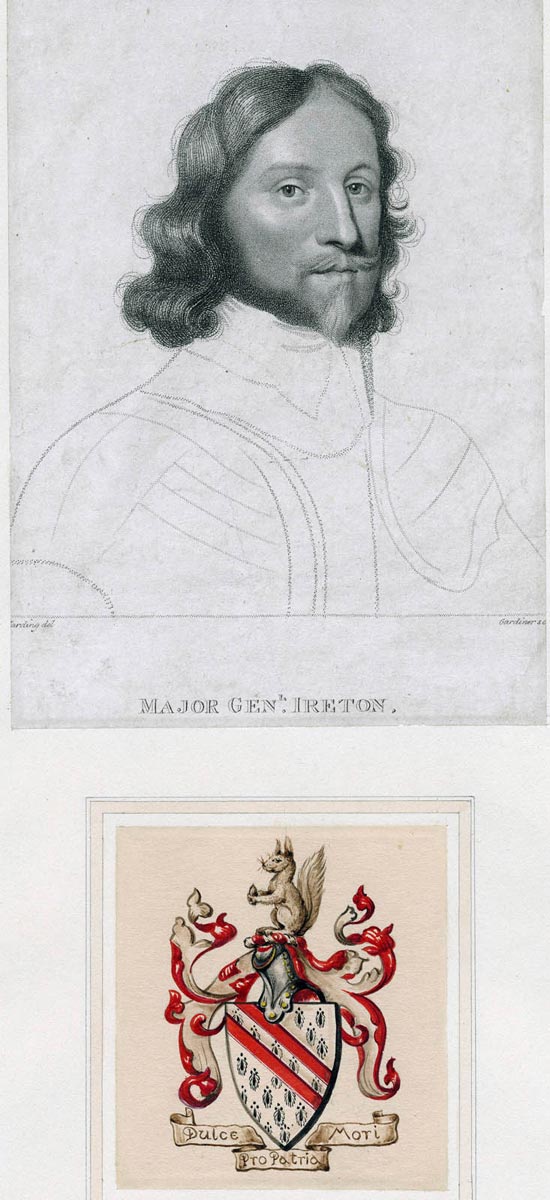Henry Ireton
Henry Ireton, Parliamentary official and son in law of Oliver Cromwell, was buried in Henry VII's chapel in Westminster Abbey in 1652. However after the Restoration of Charles II to the throne the House of Commons voted on 4th December 1660 that Ireton's remains, with those of Cromwell and Judge Bradshaw, should be exhumed and the bodies hung at Tyburn (a gallows where Marble Arch in London now stands). The House of Lords concurred a few days later and Ireton and Cromwell were exhumed on 26th January 1661 and the bodies taken to the Red Lion Inn in Holborn. On the anniversary of the execution of King Charles I on 30th January the bodies were hung.
A 19th century stone over the vault where he was buried (now the Royal Air Force chapel) reads:
In this vault was interred Oliver Cromwell 1658 and in or near it Henry Ireton, his son in law 1651...
The date for Ireton is in Old Style dating, now 1652. The names of other members of Cromwell's family and army officers formerly buried here also appear on the stone.
Monument
Ireton had a stately monument, by sculptor William Wright, with effigies of him and his wife. This was mutilated not long after its erection and totally destroyed at the Restoration. A Latin inscription was printed on a broadside, which also included coats of arms "two bends in a field ermine" and "a fess with three mullets in chief" and crest of a squirrel cracking a nut, which may have been on this lost monument and this can be translated:
Beneath this dust are deposited the earthly remains of Henry Ireton, sacred to all eternity; envied by the present age, lamented by his descendants; the county of Nottinghamshire contains the fame of his noble birth but not even the whole of Britain can contain the fame of his deeds. Cromwell sensed his divine character when he received him as his son in law; it is doubtful whether father were more blessed in such a son in law, or son in law such a father. He dedicated his earliest, youthful years to academe. His gallantry took him next to the law courts, and thence to the battlefield, with the result that he seized from Apollo the palm for learning, and from Mars the palm for bravery. Thus by the sword he opened up the way to high office, and this great promoter of his own & his family's reputation enhanced the renown of his ancestors with his own deeds of renown. Ever pious in peacetime, & likewise prudent, valiant in battle & likewise blest, rarely defeated unless by treachery, never victorious unless with valour; wholly good amongst the best, he stone as the best amongst the good. Great-souled without pride, just without cruelty, forbearing towards individuals, he never prescribed laws more severe for others than for himself. Most skilled as a parliamentarian in England, most vigilant as commander in Ireland; though being at war with the Irish, he conducted affairs with such solicitude that he served (the country) by ruling, and ruled it by serving. Finally, his warlike hand had wrought so many victories and vanquished thousands of the enemy with a handful of soldiers, and he had displayed so many instances of astonishing courage, that you would have said that God Had Fought for Ireton and Ireton for God; But, oh, what a reversal of his triumphs! Having captured highly fortified strongholds, and having captured them again after they had been re-fortified, having almost despatched the enemy, their camps being destroyed and their cities having surrendered, and almost the whole of Ireland having been subjected, he was elevated from earthly to heavenly heights, amidst general lamentations, at the summons from those above, and attended by angels. He died on the 26th Nov. at Limerick, Ireland, being 42 years of age and was buried at Westminster on the 6th Feb. in the year of our Lord 1651. In eternal memory of this most noble hero, and lest so many illustrious and virtuous qualities be lost to his descendants, Hugh Peters inscribed this epigram at his own expense.
Ireton was born in 1611 at Attenborough in Nottingham, a son of German Ireton and his wife Jane. His brother John became mayor of London. Educated at Oxford he later practised as a lawyer and joined Cromwell's side in the English Civil War. He fought at the battles of Edgehill and Marston Moor. He married Oliver Cromwell's daughter Bridget (1624-62). Their son Henry married Katherine Powle and was gentleman of the horse to William III. Their daughters were Elizabeth, who married Thomas Polhill of Kent (a monument is in Otford church Kent), Jane who married Richard Lloyd, and Bridget who married Thomas Bendish. He was Member of Parliament for Appleby and tried to negotiate with Charles I but found this impossible and the king was executed in 1649. He was Cromwell's second in command in Ireland and owned a lot of land there. Catching a bad cold at the siege at Limerick he contracted a fever and died. The body was brought to Bristol and lay in state at Somerset House in London prior to interment in the Abbey.
His widow Bridget married Parliamentary General Charles Fleetwood in 1652. Their child Anne Fleetwood was one of those exhumed with the others. Bridget was buried at St Anne's church, Blackfriars in London. General Fleetwood married thirdly Mrs Mary Hartopp and died in 1692 being buried at Bunhill Fields, London.
Further Reading

This image can be purchased from Westminster Abbey Library
Image © 2024 Dean and Chapter of Westminster

This image can be purchased from Westminster Abbey Library
Image © 2024 Dean and Chapter of Westminster










